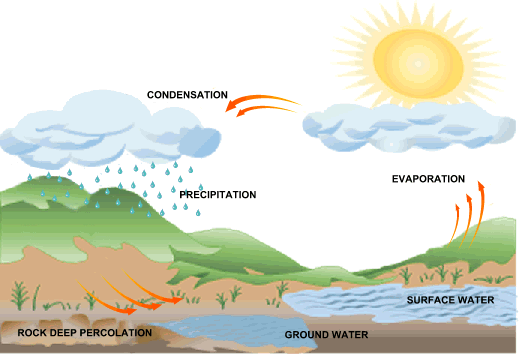

Water Resources
WATER RESOURCES
Need and Importance of Water
According to the theory of evolution, life began with water. Water comprises 70% of the human body. It is the basis for life in any ecosystem because it directly supports the links in the food chain. Enough water intake keeps disease away. Without water the skin loses its elasticity, blood becomes thicker and cells can’ t carry on their work. Water is needed to digest food and for smooth functioning of muscles, nerves and joints. Water flushes toxins through the kidney and keeps the skin supple and soft. Water is more than what many see as simply H20. It has many unique properties. Water has been called the universal solvent because its configuration breaks apart many compounds and also prevents them from recombining. Water dissolves natural chemical and nutrients necessary for life’s processes so they can be easily absorbed by, and carried throughout, the human body. It is believed that the human body better absorbs many beneficial minerals and nutrients from water . than from foods. In addition water is instrumental in flushing the body of wastes. On earth then, water is life. Further water is one of the modes of transmission of diseases. Hence the water for domestic needs of the people is to be properly treated and supplied through a planned water supply projects to protect the public health.
Water Resources Roughly 75% of the earth’s surface is covered with water. Total volume of water available on the earth is 1400 Mkm3. But only 0.15% of the world’s water is useful for beneficial purposes like domestic, agricultural and industrial needs. This usable water is not equitably distributed among the countries and among the various regions in a country. In many regions water is a scarce resource.
Objectives of Water Supply Projects
The objectives of water supply projects are to supply to the people
- SAFE water, i.e., the water free from disease producing pathogens; such as harmful bacteria, virus, and parasites.
- CLEAN water, i.e., the water free from excessive concentration of harmful chemical substances,
- ADEQUATE quantity of water to meet the basic needs and the other requirements of the people,
- at CONVENIENT points, preferably through house service connection, and
- at ECONOMIC costs.
WATER SOURCES
HYDROLOGIC CYCLE

- The Hydrologic Cycle
The Above Figure illustrates the hydrologic cycle. When gets heated by sun water from oceans, lakes rivers, etc., water evaporates to become water vapour, which passes into atmosphere where it forms clouds. Plants are also contributing significant quantities of vapour by evapo-transpiration. The water vapour eventually condenses, falling as rain or snow, often at a considerable distance away from the point of evaporation. Some quantity of rainfall percolates into the ground and stored in the pores of the substrata as groundwater. The remaining quantity runs along the slopes of the ground surface as rivers and streams and finally joins the oceans. The continuing process of evaporation, vapourization, condensation, and precipitatio moves water between the five portions of the hydrologic cycle: Oceans; the water vapour in the atmosphere (clouds); snow fall or rainfall; groundwater; and surface water in lakes and streams. Water vapour can travel long distance before it condenses. The hydrologic cycle is a natural water treatment and recycling process. The cycle is continuous one and so water is a renewable resource. This cycle is fundamental to terrestrial life, since without fresh water life on the earth would not exist.
SURFACE WATER SOURCES
Surface water is that water that is open to the atmosphere and results from overland flow. It is also said to be the result of surface runoff. Surface water is found flowing or standing on the surface such as streams, rivers, ponds, lakes and reservoirs. The water from these sources after purification could be used for water supplies.
The important surface water sources are:
- Natural lakes and ponds,
- Streams and rivers, and
- Artificially made Impounding reservoirs.
The quality and quantity of water depends on a combination of climatic and geological factors. The recent pattern of rainfall, for example, is less important in enclosed water bodies such as lakes and reservoirs where water is collected over a long period and stored; However in rivers and streams where the water is in a dynamic state of constant movement, the volume of water is dependent on the pattern of rain fall.
Leave a Reply






 LIKE TO GET UPDATES
LIKE TO GET UPDATES  TO GET EXPERT GUIDE
TO GET EXPERT GUIDE